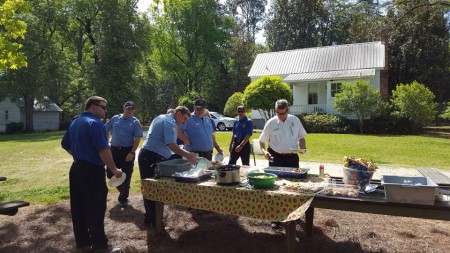Wow! What a day! For the last several hours we’ve had 5 fire trucks and about 20 men and women in turnout gear crawling all over our historic house museum! No, we didn’t have a fire, fortunately; we had a training exercise.
Long before I was in charge of a historic site I learned to make friends with the local police and fire departments. It was pretty simple when my museum was located right next door. The response time was instantaneous. Now that I work in a different town the departments are a bit farther away. My site is rural and people in this area are known for their pyro tendencies–got leaves? Burn ‘em! Got trash? Burn it! Old car? Burn it! Bored on a Sunday night? Light a bonfire!
Needless to say, I was a bit worried about the safety of the site in case one of those trash piles got away! So, I started inviting the local fire department (and police, but they’re always too busy) to come out to the site every year or every other year for a training day. Firefighters are required to do a certain number of training hours every year to maintain their certifications. They often do them at a local fire facility, but they can earn the hours by touring and assessing local businesses. This is true for paid as well as volunteer firefighters.
Every two years I call the Office Manager of our local volunteer department. She works with the Chief to assign one of their quarterly trainings to come out to our site. They bring all of the trucks they think might possibly respond to an incident here. It’s really impressive! We have them in for coffee and muffins. Then, they get an attic to basement walk through of each and every building on site (we have 14). Every electrical, gas, and water shutoff is located. They pace out distances to hydrants. They determine which tree limbs we need to cut to facilitate getting in the ladder trucks. They map where chemicals are stored–like gas for the mowers or paint for touch-ups. They make notes about when people, like interns, will be living onsite. And, they come up with firefighting and rescue plans for the site. Most importantly, I can convey to them the significance of the site and its collections. They develop a sense of ownership and want to protect the resource.
We always end the training with a home cooked lunch, a highlight for men and women that are often under-appreciated!
What has emerged from this endeavor is a positive relationship with our local protectors. Every fire truck carries an incident plan for our site. When the alarms go off in the middle of the night–from a lizard scurrying across the room or a ladybug crawling into a smoke detector–the response time is lightning fast. We also see an increase in visitor numbers as the newly hired firefighters bring their families to visit.
All of the planning and training in the world can’t always stop a fire from devastating a house museum, but it can help our piece of mind. Make friends with your local firefighters!
Resources:
- Risk Assessment: What’s Your Kryptonite? (StEPs Lab/ Recorded Webinar)
- Risk Assessment and Management for Collections (StEPs Lab/ Recorded Webinar)
- National Trust for Historic Preservation’s 10 Tips for Preventing and Responding to a Fire at a Historic House.
- AASLH’s MayDay Emergency Preparedness Resource List






